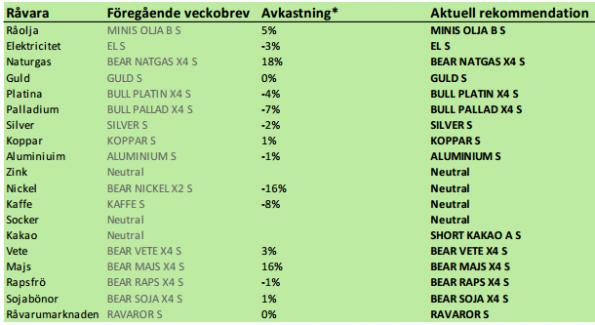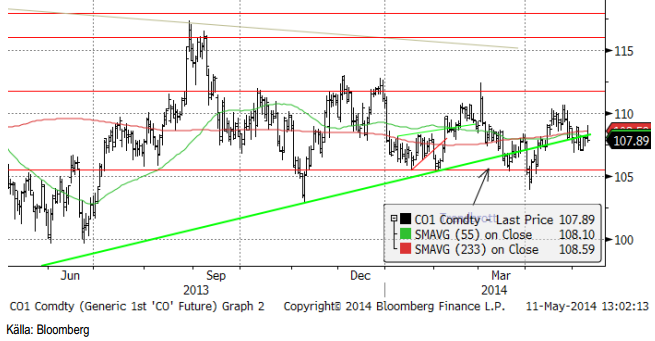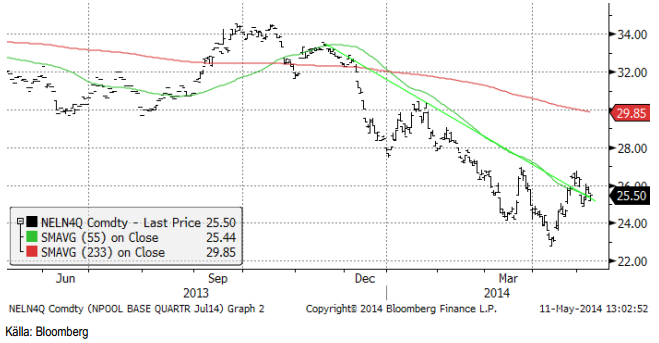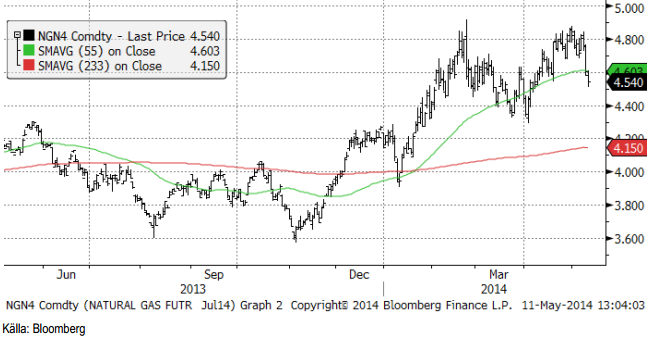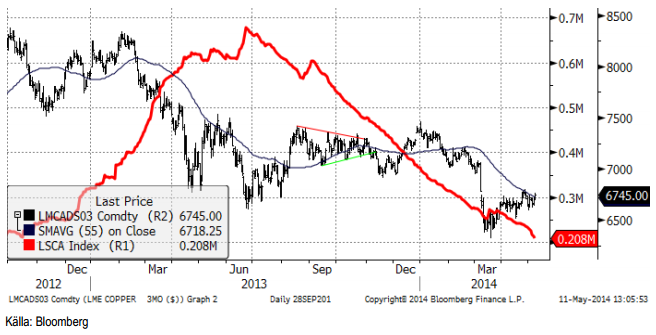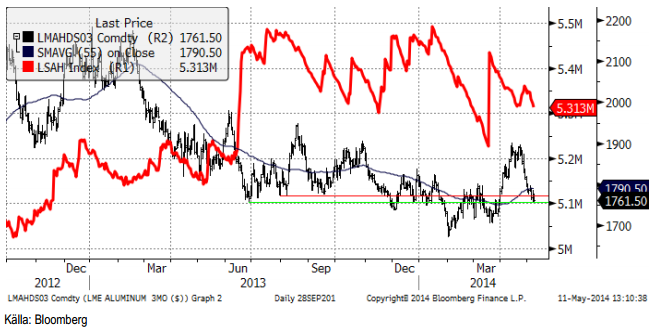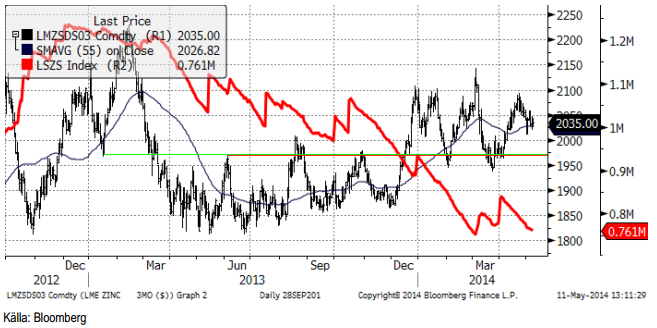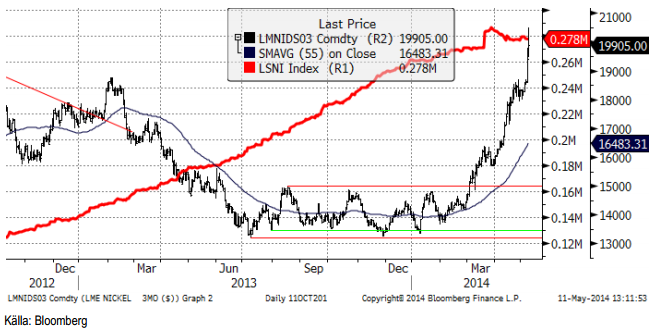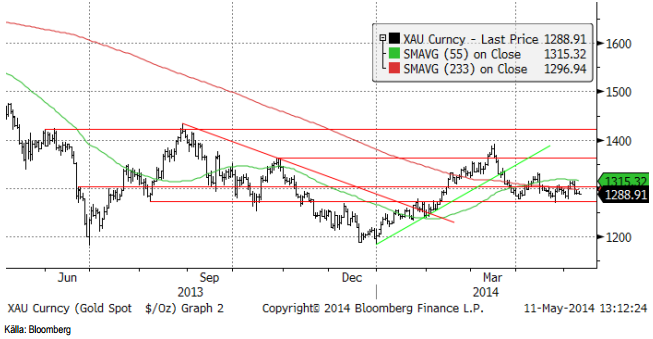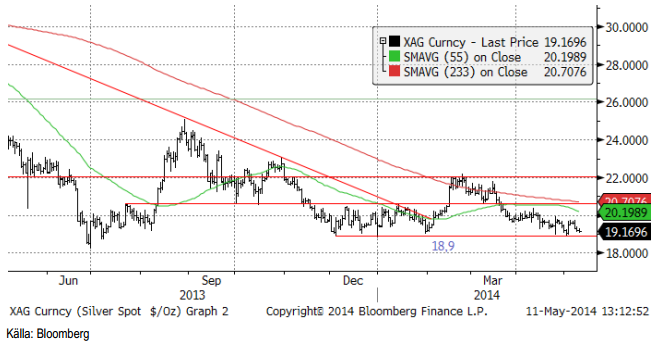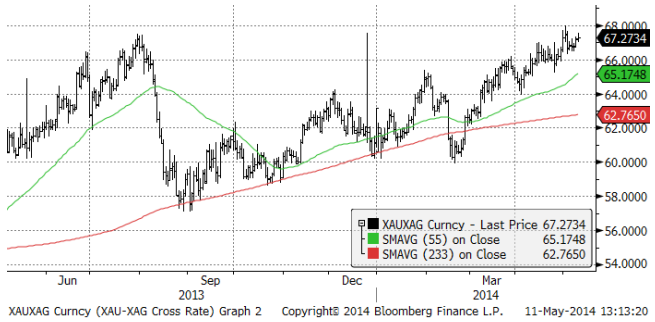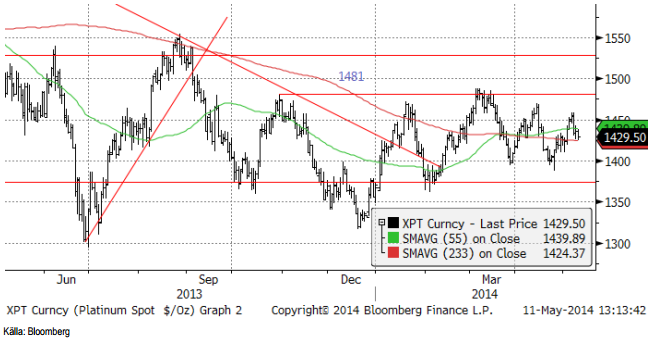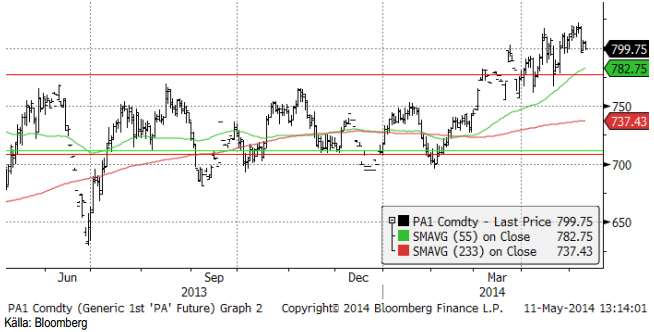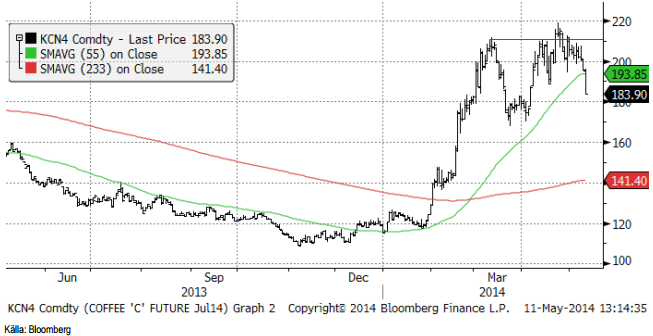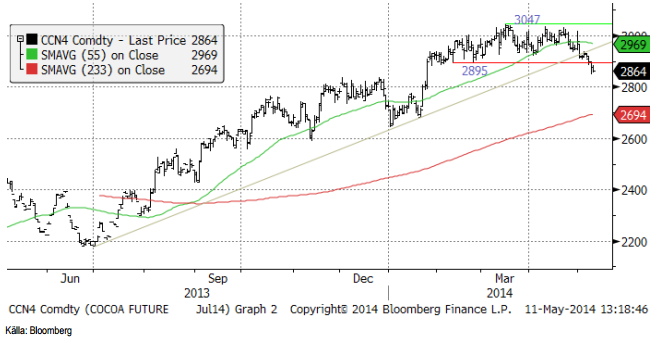Analys
SEB – Råvarukommentarer, 12 maj 2014
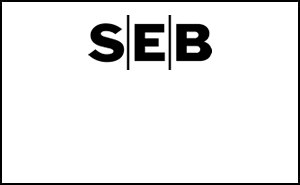
Rekommendationer
Kort sammanfattning
ECB-chefen Mario Draghis kommentar i torsdags till varför euron är så stark just nu, att det beror på att kapitalflykten från Ryssland kan ha varit 220 miljarder och inte de 70 miljarder dollar som Rysslands centralbank rapporterat, är högintressant för ett par marknader. I Rysslands valutareserv ingår t ex guld, som det gör för alla länder, vare sig man har något eller inte. Rysslands centralbanks innehav av platina och palladium är däremot statshemligheter. Vi erfar ett Rysslands centralbank sålt en hel del och även om de kan ha lite kvar, så behåller de detta av strategiska anledningar. Vi tror att säljtrycket på palladium i stort sett är borta och att priset därmed kan gå in i en kraftig hausse. Mer om det inne i brevet.
Det kom tre viktiga rapporter inom lantbrukssektorn i veckan som gick. I torsdags publicerade först CONAB sin rapport för maj, där informationen om sojabönorna tilldrog sig mest intresse. Senare samma dag publicerade FAO/AMIS sin rapport för månaden och på fredagskvällen kom USDA med sin maj-rapport, som för första gången presenterade estimat för året 2014/15. FAO/AMIS rapport var överlag negativ för priserna på spannmål och oljeväxter och det var USDA:s rapport också, precis som vi väntat oss.
Kinas importstatistik presenterades tidigare i veckan och den visade starka siffror för importen för en rad råvaror, inte bara för sojabönor. Media gjorde en stor sak av att allt från importen av råolja till sojabönor var stark. Om man dock sätter denna enskilda månad i perspektiv av de senaste åren, snarare bekräftas bilden av en takt i råvaruimporten som mattas.
Geopolitisk oro, som t ex Rysslands krig med Ukraina, gör att människor blir extra sparsamma och det gäller även för konsumtionen av dyrare mat (kött, etc). Konsumtionen av framförallt foderspannmål kan därför påverkas negativt med högre lager och lägre pris på lite sikt som konsekvens, allt annat lika. Av ECB chefen Mario Draghis kommentar till den starka euro-växelkursen, att kapitalflykten från Ryssland varit 220 miljarder dollar den senaste tiden, och inte 70 mdr dollar, som Rysslands centralbank rapporterat, tyder på att Ryssland drabbats av finansiell härdsmälta.
Det är knappast något som gynnar konsumtionen av dyrare mat inom landet. Detta ska man ta i beaktande när man ser på FAO/AMIS och USDA:s estimat av konsumtion av spannmål under 2014/15 och utgående lager. Utgående lager kan bli högre pga lägre konsumtion i folkrika länder, t ex Ryssland. Det innebär att priset på ett års sikt kan bli ännu lägre än de låga nivåer som USDA förutspår på basis av sina utbuds- och efterfrågebalanser.
Råolja – Brent
Amerikanska raffinaderier börjar komma igång igen efter att ha ställt om till sommarproduktion (mer bensin, mindre eldningsolja). Det innebär att vi passerat den säsongsmässigt svagaste tiden för oljemarknaden. Bråket i Libyen med väsentligt mindre produktion än vad som hade varit möjligt, gjorde att priset på olja höll sig högt i april. Vad vi erfar är att Libyen nu bara producerar ca 250,000 fat per dag. Rebellerna har just nu övertaget i konflikten inom landet och hotar att ta tillbaka två av oljehamnarna.
Råoljelagren i USA minskade något, främst beroende på lägre import.
Vi rekommenderar en kort position i olja, t ex med MINIS OLJA B S eller MINIS OLJA A S
Elektricitet
Förra veckan gick vi över till köprekommendation med tillägget att försöka vänta på en rekyl att köpa på. Kanske var det några som hann med att göra det i den rekyl som faktiskt inföll i veckan.
Vi behåller köprekommendationen. Stöd finns på 24 euro och motstånd på 27.
Naturgas
Priset på naturgas befinner sig i en fallande trend. Stöd finns på 4.40 och på lägre nivå 4.20. Vi fortsätter med säljrekommendation.
Koppar
Det Indonesiska exportförbudstemat har av uppenbara skäl varit fixerat vid nickel. Kopparmalmsexporten har varit undantagen, men exportskatterna har ännu inte avgjorts slutgiltigt. Detta har dragit ut på tiden sedan början av året. Kopparmarknaden saknar därför
material från Indonesien.
Den fysiska premien CIF Shanghai har fortsatt uppåt till 130 dollar per ton från 100 dollar för två veckor sedan och 75 dollar i mars. Detta är ett tecken på att efterfrågan ökar snabbare än det går att forsla in material.
Tekniskt är 6750 dollar en viktig motståndsnivå, som ser ut att bli svår för kopparmarknaden att handla över, rent tekniskt, men å andra sidan ser lagren ut att minska stadigt. Teknisk analys säger, var försiktig, men fundamenta säger köp. Vem vinner? Vi fortsätter med köprekommendation i alla fall.
Aluminium
De senaste veckorna har varit något av en besvikelse för dem som trodde att vi hade sett någon slags trendvändning i den här marknaden. Stödet vid 1850 dollar gav vika och marknaden handlade så lågt som 1755 i fredags. Kurvrörelserna de senaste veckorna med press på de längre terminskontraktens contango, antyder att marginella producenter tar tillfället i akt att prissäkra framtida produktion. Vi har sett intresse från konsumenter på vägen ner, men uppenbarligen inte tillräckligt för att hindra marknaden från att falla. Investerarkollektivet lämnar uppenbarligen sina långa positioner och går i någon utsträckning kort igen. Som vi har skrivit i tidigare veckobrev, kommer det att ta tid för marknaden att beta av de senaste årens överproduktion. Men inte desto mindre känns det som om något viktigt har hänt då marknaden tagit ett kliv uppåt. Man ska dock ställa in sig på att priset kan röra sig sidledes ett tag. 1750 dollar-nivån kommer att vara viktig den kommande veckan. Vi tror den håller och rekommenderar köp här.
Zink
Metall har stadigt tagit ut från LME:s lagerhus sedan början av april. Frågan nu är om detta går till konsumtion eller inte. Misstanken som föddes tidigt, att metallen flyttades till billigare lager för att ingå i finansieringsaffärer är mindre trolig nu, när contangot är mindre. Det är bara i aluminium som contangot fortfarande är bra nog för den sortens affärer. Uttagen av zink från lagren handlar därför troligtvis om riktig efterfrågan och det är ett gott tecken för zinkmarknaden. Prisrörelserna på LME tycks vara en återspegling av lagerförändringen. Just nu verkar dock priset vara fast inom intervallet 1950 – 2150 dollar.
Nickel
Nickelpriset har stigit med imponerande 10% sedan förra veckan. Det är den sjätte veckan i följd som priset stiger. De senaste 14 veckorna är det bara en vecka när priset gått ner. Hittills i år har priset gått upp med 45%. Det är fortfarande samma faktorer som ligger bakom prisuppgången, dvs Indonesien och Ryssland. Den här veckan tillkom emellertid ytterligare en faktor: Vales gruva i Nya Kaledonien har produktionsproblem. Gruvan är liten, och problemen ”borde” inte ha fått den effekt på priset som den fick.
Veckans prisuppgång skedde nästan helt och hållet mellan onsdagen och fredagen. Det är intressant att uppgångarna sker i asiatisk handel. När vi kommer in på morgonen är priset redan högre. Sedan är priset oförändrat, eller faller tillbaka lite. Det kommer rapporter om att kinas produktion av NPI sjunker. Fördelen för NPI-baserad produktion av rostfritt stål var beroende av billig malm från Indonesien. Visserligen har kinesiska verk byggt upp stora lager som de tar av nu, men snart tar den traditionella framställningsmetoden över, med den ekonomi på nickel som det innebär. De flesta analytiker menar att golvet för nickelpriset då blir ca 18,000 dollar per ton. Tillverkningen av rostfritt stål använder ca 60% av nickelutbudet i världen och vi ser tecken på en återhämtning där också. Enligt CRU är industrin tillbaka på en årlig tillväxttakt på 5%. Även haussen i nickelpriset kan ge efterfrågan på rostfritt stål en boost. Köpare av rostfritt stål börjar boka in framtida köp.
Nickelmarknaden har botten bakom sig.
Guld
Guldpriset föll tillbaka efter att Ryska uttalanden varit mindre aggressiva i veckan som gick. Priset rör sig inom ett smalt intervall och stödet vid 1880 är fortfarande intakt. Vi fortsätter att vara försiktigt positiva till guld.
Vi rekommenderar köp av GULD S.
Silver
Silverpriset föll tillbaka i veckan, tillsammans med guld, efter att uttalanden från Ryssland var mindre krigiska än tidigare. När priset nu närmar sig stödet på 18.90 finns därför goda tillfällen att köpa silver.
Nedan ser vi ett diagram över priset på guld uttryckt i silver. Det går alltså över 67 finuns silver på varje fin-uns av guld (förra veckan 66 uns silver). Som vi ser är det en hög nivå, dvs silver är billigt i förhållande till guld.
Vi anser att silver är mer köpvärt än guld och skulle vilja köpa på de här nivåerna. Vi rekommenderar köp av SILVER S.
Platina & Palladium
Mario Draghi, chefen för ECB, sade i torsdags att kapitalutflödet från Ryssland kanske varit 220 miljarder dollar, så mycket att det höjt växelkursen på euron. Rysslands centralbank har sagt att utflödet varit 70 miljarder dollar. Detta är dock baserat på den offentliga delen av valutareserven och där ingår guld, men inte palladium, platina och diamanter. Det sägs rakt ut att innehavet av palladium är en statshemlighet i Ryssland. Om Rysslands centralbank sålt palladium, platina och diamanter kan utflödet alltså vara större än det officiella. GFMS menar att Rysslands centralbank hade uppskattningsvis 0.3 miljoner uns palladium innan krisen. Detta förslår inte alls för skillnaden mellan 70 och 220 miljarder dollar. Men de har även vad vi erfar haft platina och diamanter, såväl inom centralbanken som i den strategiska reserven. Vi erfar att metall har flyttats till Schweiz varifrån det sålts vidare. Vi är inte säkra på att allt har lämnat Schweiz. Metall kan finnas i låsta lager, kanske av den sorts lagerhotell som finns på Klotenflygplatsens ”frihamnslager”. Det kan vara så att någon spelare sitter med detta som en lång position och är redo att sälja om priset kommer upp. Vi tror inte att Ryssland har metall kvar som man vill sälja. Det (lilla) man har kvar behövs som en strategisk reserv.
Säljtrycket kan alltså i stort sett vara borta och med det intresse som finns, så skulle priset på palladium och till viss del kanske även platina kunna gå väsentligt mycket högre
Skulle västvärlden gå till nivå 3 i sanktioner mot Ryssland, tror vi att man kommer att låta olje- och gasindustrin vara. Man vill inte ha ett högt pris på gas. Vi tror att man kommer att ge sig på gruvindustrin. Det är då Norilsk Nickel som är det uppenbara målet. Norilsk producerar nickel, platina och palladium. Det finns även en järnmalmsproduktion som kan bli lidande av sanktioner, men huvudsakligen är det palladium och platina som drabbas.
Det allmänna valet i Sydafrika den 7 maj gav ANC drygt 60% av rösterna, vilket innebär att de fortsätter att styra landet som de gjort de senaste 20 åren. Inflationen ligger på en hög nivå, 12% om man extrapolerar de senaste förändringarna i konsumentpriserna. Det är över centralbankens övre gräns på 6% för inflationen och det kan innebära kommande räntehöjningar. Å andra sidan är BNP-tillväxten låg på 1.9% förra året. SEB:s Emerging Markets-ekonom väntar sig att den stiger marginellt till 2.2% i år, men detta kan grusas om det blir räntehöjningar.
Prisdiagrammet på palladium ser vi nedan.
Vi rekommenderar köp av PLATINA S och PALLADIUM S, eller BULL PLATINA X4 S eller BULL PALLAD X4 S.
För den som vill ta ännu mer risk, finns nu även BULL PALLAD X5 S.
Kaffe
Förra veckan hade vi köp, men skrev också att man skulle ta stoppen om priset gick under 200 cent. Det gjorde priset i torsdags, så vi hoppas att alla är ute ur sina långa positioner nu. Vi har neutral, efter stoppen. Och med tanke på att det förmodligen finns tekniskt stöd vid 180 cent, är det inte läge för att gå kort just nu utan behåller neutral.
En anledning till prisfallet var att sannolikheten för ett El Niño minska kraftigt i den senaste prognosen från Australiens Meteorologiska Byrå. Det innebär att risken för skador på skörden av robusta i Indonesien och Vietnam också minskat på motsvarande sätt.
Neutral rekommendation på kaffe.
Kakao
Priset på kakao ligger nu i fallande trend och vi väljer att gå kort. Det är en fint rundad toppformation. Tekniskt stöd finns på 2800 dollar. Vi rekommenderar köp av SHORT KAKAO A S, som har en hävstång strax under -1.
För övriga råvaror från jordbruket se dagens andra analysbrev från SEB.
[box]SEB Veckobrev Veckans råvarukommentar är producerat av SEB Merchant Banking och publiceras i samarbete och med tillstånd på Råvarumarknaden.se[/box]
Disclaimer
The information in this document has been compiled by SEB Merchant Banking, a division within Skandinaviska Enskilda Banken AB (publ) (“SEB”).
Opinions contained in this report represent the bank’s present opinion only and are subject to change without notice. All information contained in this report has been compiled in good faith from sources believed to be reliable. However, no representation or warranty, expressed or implied, is made with respect to the completeness or accuracy of its contents and the information is not to be relied upon as authoritative. Anyone considering taking actions based upon the content of this document is urged to base his or her investment decisions upon such investigations as he or she deems necessary. This document is being provided as information only, and no specific actions are being solicited as a result of it; to the extent permitted by law, no liability whatsoever is accepted for any direct or consequential loss arising from use of this document or its contents.
About SEB
SEB is a public company incorporated in Stockholm, Sweden, with limited liability. It is a participant at major Nordic and other European Regulated Markets and Multilateral Trading Facilities (as well as some non-European equivalent markets) for trading in financial instruments, such as markets operated by NASDAQ OMX, NYSE Euronext, London Stock Exchange, Deutsche Börse, Swiss Exchanges, Turquoise and Chi-X. SEB is authorized and regulated by Finansinspektionen in Sweden; it is authorized and subject to limited regulation by the Financial Services Authority for the conduct of designated investment business in the UK, and is subject to the provisions of relevant regulators in all other jurisdictions where SEB conducts operations. SEB Merchant Banking. All rights reserved.
Analys
Tightening fundamentals – bullish inventories from DOE

The latest weekly report from the US DOE showed a substantial drawdown across key petroleum categories, adding more upside potential to the fundamental picture.

Commercial crude inventories (excl. SPR) fell by 5.8 million barrels, bringing total inventories down to 415.1 million barrels. Now sitting 11% below the five-year seasonal norm and placed in the lowest 2015-2022 range (see picture below).
Product inventories also tightened further last week. Gasoline inventories declined by 2.1 million barrels, with reductions seen in both finished gasoline and blending components. Current gasoline levels are about 3% below the five-year average for this time of year.
Among products, the most notable move came in diesel, where inventories dropped by almost 4.1 million barrels, deepening the deficit to around 20% below seasonal norms – continuing to underscore the persistent supply tightness in diesel markets.
The only area of inventory growth was in propane/propylene, which posted a significant 5.1-million-barrel build and now stands 9% above the five-year average.
Total commercial petroleum inventories (crude plus refined products) declined by 4.2 million barrels on the week, reinforcing the overall tightening of US crude and products.


Analys
Bombs to ”ceasefire” in hours – Brent below $70

A classic case of “buy the rumor, sell the news” played out in oil markets, as Brent crude has dropped sharply – down nearly USD 10 per barrel since yesterday evening – following Iran’s retaliatory strike on a U.S. air base in Qatar. The immediate reaction was: “That was it?” The strike followed a carefully calibrated, non-escalatory playbook, avoiding direct threats to energy infrastructure or disruption of shipping through the Strait of Hormuz – thus calming worst-case fears.

After Monday morning’s sharp spike to USD 81.4 per barrel, triggered by the U.S. bombing of Iranian nuclear facilities, oil prices drifted sideways in anticipation of a potential Iranian response. That response came with advance warning and caused limited physical damage. Early this morning, both the U.S. President and Iranian state media announced a ceasefire, effectively placing a lid on the immediate conflict risk – at least for now.
As a result, Brent crude has now fallen by a total of USD 12 from Monday’s peak, currently trading around USD 69 per barrel.
Looking beyond geopolitics, the market will now shift its focus to the upcoming OPEC+ meeting in early July. Saudi Arabia’s decision to increase output earlier this year – despite falling prices – has drawn renewed attention considering recent developments. Some suggest this was a response to U.S. pressure to offset potential Iranian supply losses.
However, consensus is that the move was driven more by internal OPEC+ dynamics. After years of curbing production to support prices, Riyadh had grown frustrated with quota-busting by several members (notably Kazakhstan). With Saudi Arabia cutting up to 2 million barrels per day – roughly 2% of global supply – returns were diminishing, and the risk of losing market share was rising. The production increase is widely seen as an effort to reassert leadership and restore discipline within the group.
That said, the FT recently stated that, the Saudis remain wary of past missteps. In 2018, Riyadh ramped up output at Trump’s request ahead of Iran sanctions, only to see prices collapse when the U.S. granted broad waivers – triggering oversupply. Officials have reportedly made it clear they don’t intend to repeat that mistake.
The recent visit by President Trump to Saudi Arabia, which included agreements on AI, defense, and nuclear cooperation, suggests a broader strategic alignment. This has fueled speculation about a quiet “pump-for-politics” deal behind recent production moves.
Looking ahead, oil prices have now retraced the entire rally sparked by the June 13 Israel–Iran escalation. This retreat provides more political and policy space for both the U.S. and Saudi Arabia. Specifically, it makes it easier for Riyadh to scale back its three recent production hikes of 411,000 barrels each, potentially returning to more moderate increases of 137,000 barrels for August and September.
In short: with no major loss of Iranian supply to the market, OPEC+ – led by Saudi Arabia – no longer needs to compensate for a disruption that hasn’t materialized, especially not to please the U.S. at the cost of its own market strategy. As the Saudis themselves have signaled, they are unlikely to repeat previous mistakes.
Conclusion: With Brent now in the high USD 60s, buying oil looks fundamentally justified. The geopolitical premium has deflated, but tensions between Israel and Iran remain unresolved – and the risk of missteps and renewed escalation still lingers. In fact, even this morning, reports have emerged of renewed missile fire despite the declared “truce.” The path forward may be calmer – but it is far from stable.
Analys
A muted price reaction. Market looks relaxed, but it is still on edge waiting for what Iran will do

Brent crossed the 80-line this morning but quickly fell back assigning limited probability for Iran choosing to close the Strait of Hormuz. Brent traded in a range of USD 70.56 – 79.04/b last week as the market fluctuated between ”Iran wants a deal” and ”US is about to attack Iran”. At the end of the week though, Donald Trump managed to convince markets (and probably also Iran) that he would make a decision within two weeks. I.e. no imminent attack. Previously when when he has talked about ”making a decision within two weeks” he has often ended up doing nothing in the end. The oil market relaxed as a result and the week ended at USD 77.01/b which is just USD 6/b above the year to date average of USD 71/b.

Brent jumped to USD 81.4/b this morning, the highest since mid-January, but then quickly fell back to a current price of USD 78.2/b which is only up 1.5% versus the close on Friday. As such the market is pricing a fairly low probability that Iran will actually close the Strait of Hormuz. Probably because it will hurt Iranian oil exports as well as the global oil market.
It was however all smoke and mirrors. Deception. The US attacked Iran on Saturday. The attack involved 125 warplanes, submarines and surface warships and 14 bunker buster bombs were dropped on Iranian nuclear sites including Fordow, Natanz and Isfahan. In response the Iranian Parliament voted in support of closing the Strait of Hormuz where some 17 mb of crude and products is transported to the global market every day plus significant volumes of LNG. This is however merely an advise to the Supreme leader Ayatollah Ali Khamenei and the Supreme National Security Council which sits with the final and actual decision.
No supply of oil is lost yet. It is about the risk of Iran closing the Strait of Hormuz or not. So far not a single drop of oil supply has been lost to the global market. The price at the moment is all about the assessed risk of loss of supply. Will Iran choose to choke of the Strait of Hormuz or not? That is the big question. It would be painful for US consumers, for Donald Trump’s voter base, for the global economy but also for Iran and its population which relies on oil exports and income from selling oil out of that Strait as well. As such it is not a no-brainer choice for Iran to close the Strait for oil exports. And looking at the il price this morning it is clear that the oil market doesn’t assign a very high probability of it happening. It is however probably well within the capability of Iran to close the Strait off with rockets, mines, air-drones and possibly sea-drones. Just look at how Ukraine has been able to control and damage the Russian Black Sea fleet.
What to do about the highly enriched uranium which has gone missing? While the US and Israel can celebrate their destruction of Iranian nuclear facilities they are also scratching their heads over what to do with the lost Iranian nuclear material. Iran had 408 kg of highly enriched uranium (IAEA). Almost weapons grade. Enough for some 10 nuclear warheads. It seems to have been transported out of Fordow before the attack this weekend.
The market is still on edge. USD 80-something/b seems sensible while we wait. The oil market reaction to this weekend’s events is very muted so far. The market is still on edge awaiting what Iran will do. Because Iran will do something. But what and when? An oil price of 80-something seems like a sensible level until something do happen.
-

 Nyheter4 veckor sedan
Nyheter4 veckor sedanStor uppsida i Lappland Guldprospekterings aktie enligt analys
-

 Nyheter4 veckor sedan
Nyheter4 veckor sedanSilverpriset släpar efter guldets utveckling, har mer uppsida
-

 Nyheter3 veckor sedan
Nyheter3 veckor sedanUppgången i oljepriset planade ut under helgen
-

 Nyheter2 veckor sedan
Nyheter2 veckor sedanMahvie Minerals växlar spår – satsar fullt ut på guld
-

 Nyheter3 veckor sedan
Nyheter3 veckor sedanLåga elpriser i sommar – men mellersta Sverige får en ökning
-

 Analys3 veckor sedan
Analys3 veckor sedanVery relaxed at USD 75/b. Risk barometer will likely fluctuate to higher levels with Brent into the 80ies or higher coming 2-3 weeks
-

 Nyheter2 veckor sedan
Nyheter2 veckor sedanOljan, guldet och marknadens oroande tystnad
-

 Nyheter2 veckor sedan
Nyheter2 veckor sedanJonas Lindvall är tillbaka med ett nytt oljebolag, Perthro, som ska börsnoteras


